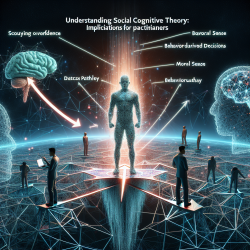Introduction
Cyberbullying has emerged as a pervasive issue in the digital age, impacting individuals across various demographics. The study titled "Antecedents and outcomes of cyberbullying among Chinese university students: verification of a behavioral pathway model" provides a comprehensive analysis of the factors influencing cyberbullying behaviors, utilizing Social Cognitive Theory (SCT) as a framework. This blog post aims to explore the implications of these findings for practitioners in the field of speech-language pathology and education, encouraging data-driven strategies to mitigate cyberbullying.
Understanding the Behavioral Pathway Model
The research identifies key variables such as overconfidence, excessive moral sense, perceived value, and happiness as significant predictors of cyberbullying behavior. The study reveals that:
- Overconfidence and excessive moral sense positively predict cyberbullying behaviors.
- Cyberbullying behaviors enhance perceived value and happiness among perpetrators.
- Perceived value and happiness further reinforce continued cyberbullying intentions.
These findings highlight the complex interplay between cognitive biases and social behaviors, emphasizing the need for targeted interventions.
Implications for Practitioners
Practitioners can leverage these insights to develop more effective intervention strategies. Here are some actionable steps:
- Address Overconfidence and Moral Sense: Educators and therapists should focus on cognitive-behavioral approaches to help students recognize and adjust their overconfidence and excessive moral judgments.
- Enhance Empathy and Social Skills: Programs that promote empathy and social understanding can mitigate the perceived value and happiness derived from cyberbullying.
- Foster Positive Online Interactions: Encourage positive online behaviors and digital citizenship to counteract the reinforcement of negative behaviors.
Encouraging Further Research
While this study provides valuable insights, it also opens avenues for further research. Practitioners are encouraged to explore:
- The role of cultural differences in shaping cyberbullying behaviors.
- Longitudinal studies to track changes in cyberbullying behaviors over time.
- Intervention efficacy across different educational settings and age groups.
Conclusion
Understanding the cognitive and behavioral pathways of cyberbullying is crucial for developing effective interventions. By focusing on the underlying cognitive biases and promoting positive social interactions, practitioners can play a pivotal role in reducing the prevalence of cyberbullying. To delve deeper into the original research, please follow this link: Antecedents and outcomes of cyberbullying among Chinese university students: verification of a behavioral pathway model.










